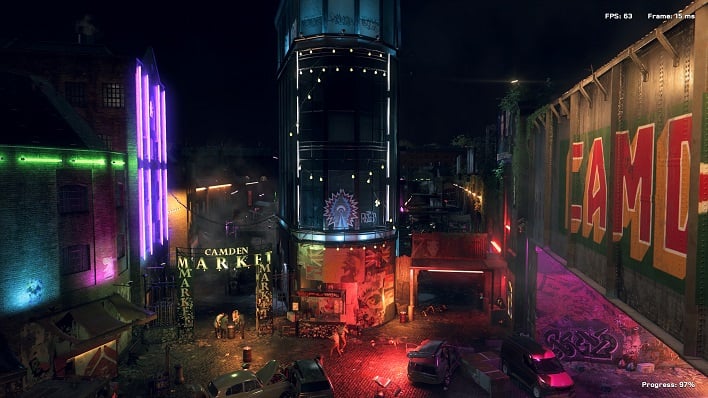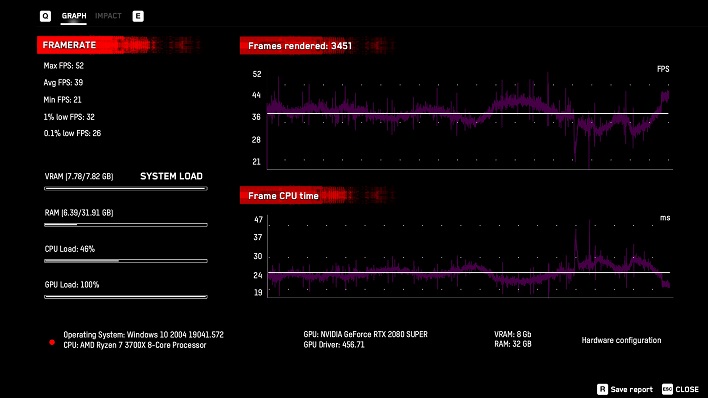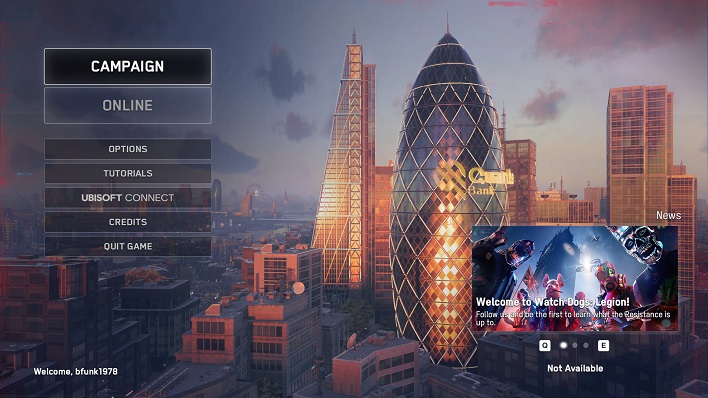Watch Dogs: Legion Graphics, Game Play & Performance Explored
Watch Dogs: Legion - Gameplay Issues and Performance
Watch Dogs: Legion - Gameplay Issues
While we were playing a preview copy of Watch Dogs: Legion, the version we were given is the day-one patch version which launches to the public today. Because of that, we felt like it was important to share any show-stopping bugs we found along the way. On this page you'll see a total of 144 total frames-per-second data points (average and 1% low) collected over the course of 144 different runs, two per combination of RTX detail, resolution, and DLSS 2.0 settings. The game crashed around once every eight runs of the benchmark, for a total of 18 crashes, and on four other occasions the menus just stopped responding to input. This was frustrating, but eventually we got the performance numbers we needed. Fortunately, the actual game very rarely crashed, but still had some bugs.First of all, UPlay itself had some connectivity issues in Watch Dogs: Legion. More often than not, Alt+Tab to get out of the game disconnects the game from Ubisoft's services, so cloud saves stop syncing. On more than one occasion, the agent we were fighting would get stuck in walls. The DLSS menu options are confusing, as it goes from None, Performance, Quality, then Balanced, and finally Ultra Performance. It's unfortunate, but Watch Dogs: Legion is buggy in the early going in a way we haven't experienced in a while.
In the actual game, there were several instances of enemy characters getting stuck. One time, we cornered a security guard and knocked him down, and he fell half-way through the door, as in the screenshot above. He'd try to get up and would yell for backup, but we couldn't touch him to knock him out. Another time, we punched a guard who was standing on top of a ledge, and he fell in slow motion to gently land on the ground below, and only then could we attack him again. In the game, we can hijack small spider-bots and drones to do our bidding, and in one mission, the spider-bot got stuck on a desk and we couldn't get it to jump so we could move again. That one caused us to restart a mission, which was particularly frustrating.
All of that is particularly troubling since, had it not been for COVID-19, the game would have shipped in March instead of the end of October. Seven extra months were apparently not enough to get the Watch Dogs totally stable. We should remember that we played a pre-release version, but we were running the day-one patch that launches alongside the game. Hopefully Ubisoft will move quickly to squash the remaining bugs.
Update 10/29/2020 6:50 PM EDT: Shortly after this article went live, NVIDIA drew our attention to this thread on Ubisoft's forums detailing a patch that should drop tomorrow, which will affect both performance and some of the bugs that we detailed above.
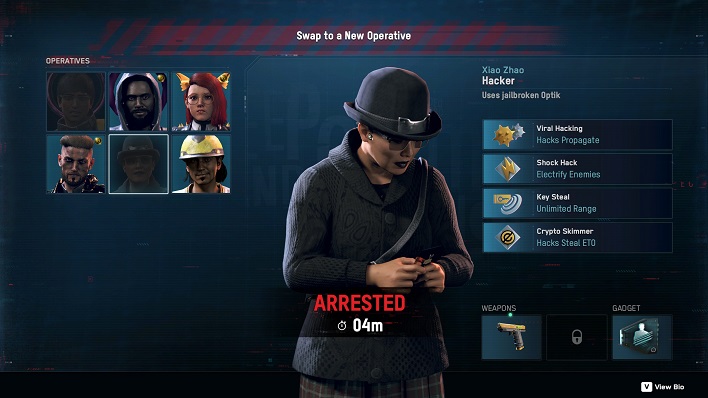
Once a character has been arrested or critically injured, a timer starts. Some recruits can shorten the cooldown.
Watch Dogs: Legion - System Requirements
While we played the campaign on our HTPC, we tested Watch Dogs: Legion on the same test platform as most of the other games we've tested over the last year: a Ryzen 7 3700X with 32 GB of DDR4-3600 memory on an ASUS X570 TUF Gaming Plus (Wi-Fi) motherboard. Because the game relies so heavily on DLSS and DXR effects, we used a GeForce RTX 2080 SUPER and GeForce RTX 2060. The 2080 SUPER could only run the game on the Very High preset due to the 8 GB VRAM limit we mentioned earlier. The GeForce RTX 2060 and its 6 GB of GDDR6 are further limited to the High preset.Before we go any farther, we should recap the game's system requirements. They're actually fairly steep compared to something like Cyberpunk 2077 or Death Stranding, both of which are other 2020 PC releases. However, these high requirements are due to the high render target Ubisoft specified. Even the minimum requirement was chosen for High detail, Medium DXR, and a 1080p render target.
|
| Spec | Minimum - 1080p High, Medium DXR, DLSS Quality | Recommended - 1440p Very High, High DXR, DLSS Quality | Ultra - 2160p, Ultra, Ultra DXR, DLSS Performance |
| CPU | Intel Core i5-8400 AMD Ryzen 5 2600 |
Intel Core i7-9700 AMD Ryzen 5 3600 |
Intel Core i9-9900K AMD Ryzen 7 3700X |
| GPU | NVIDIA GeForce RTX 2060 6 GB | GeForce RTX 3070 8 GB | GeForce RTX 3080 10 GB |
| RAM | 16 GB Dual Channel | 16 GB Dual Channel | 16 GB Dual Channel |
| SSD Free | 45 GB | 45 GB | 45 GB |
| OS | Windows 10 (64-bit only) | Windows 10 (64-bit only) | Windows 10 (64-bit only) |
Considering we're talking about graphics cards that only just came out for the Recommended and Ultra spec, very few gamers will be playing on those settings any time soon. That's especially true when considering NVIDIA's struggles with filling demand for its brand-new Ampere cards. Fortunately, we were able to find some settings that worked well for us on our test cards, and we'll test a wide variety of settings otherwise, too.
Watch Dogs: Legion - Performance
The built-in benchmark was a good sample of what goes on in-game. It happens at night with lots of neon lights, rain, and reflections all over the place. That means it uses Watch Dogs: Legion's DXR effects to their fullest, as reflections happen in puddles, windows, and even a metal statue. No two runs of the benchmark are exactly the same, owing to the fact that it's using the full game engine including AI and physics. To make sure no one setting or card was punished by a particularly complex scene, we ran each setting twice and reported the higher score. Generally speaking, the results were very consistent throughout, though.
Watch Dogs: Legion reports more than just frame rates. At the end of the run, it shows a GPU and a CPU chart, which illustrates where the bottleneck was, which will serve as an aid when choosing to upgrade a gaming PC. Also, the game can export the run to an HTML file, which it saves to a folder in the \Documents\My Games\Watch Dogs Legion folder. That HTML file constructs its own fps chart, as well. Unfortunately neither the HTML result file nor the in-game graph uses 0 as a starting point, so fluctuations in frame rate are exaggerated, and bottoming out looks much worse than it actually is.
|
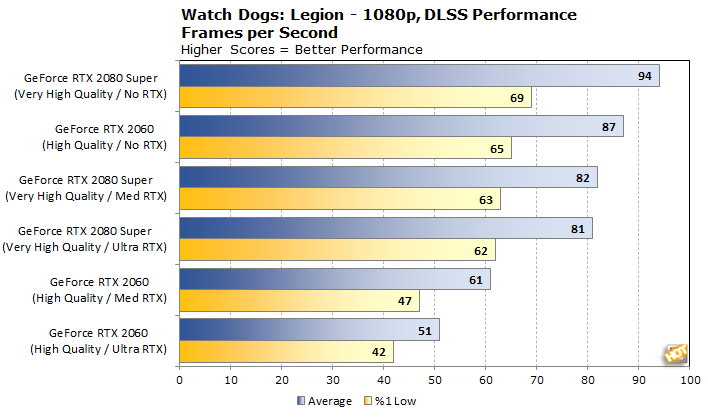
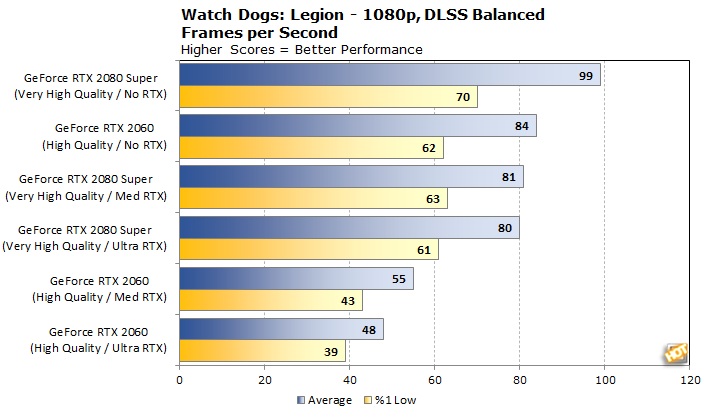
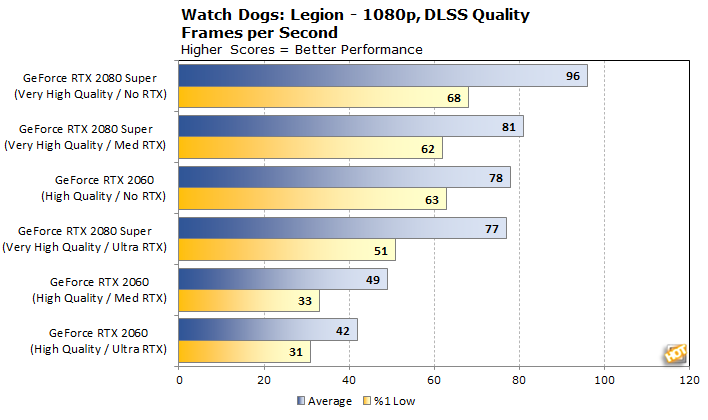
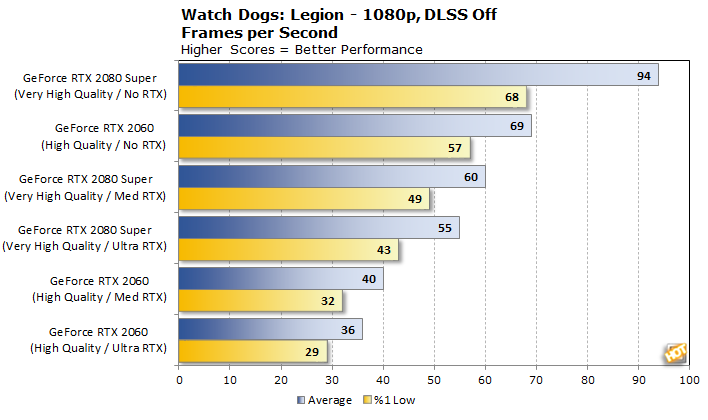
While the RTX 2060 could never quite average 60 fps with any form of ray tracing enabled at the native resolution, Performance DLSS was able to pull out a smooth result with medium DXR effects. If those effects aren't all that interesting, the average frame rate jumps all the way up to nearly 70 fps on average, which is very smooth, since the 1% low dipped below 60 just a touch. It's no surprise to see that Ubisoft's Minimum spec, which targeted High settings at 1080p with Medium DXR, hit right at 60fps on average with our GeForce RTX 2060.
|

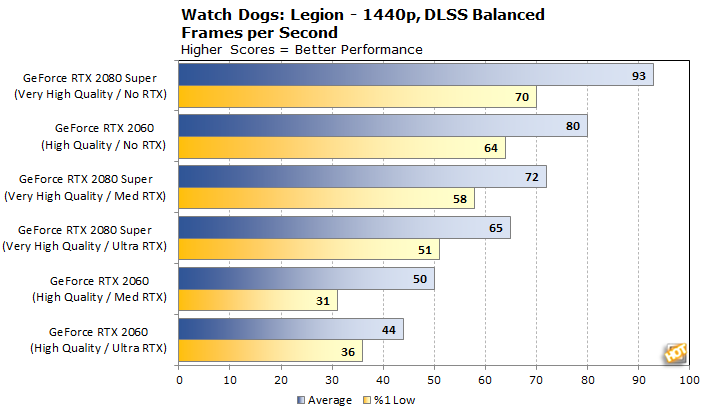
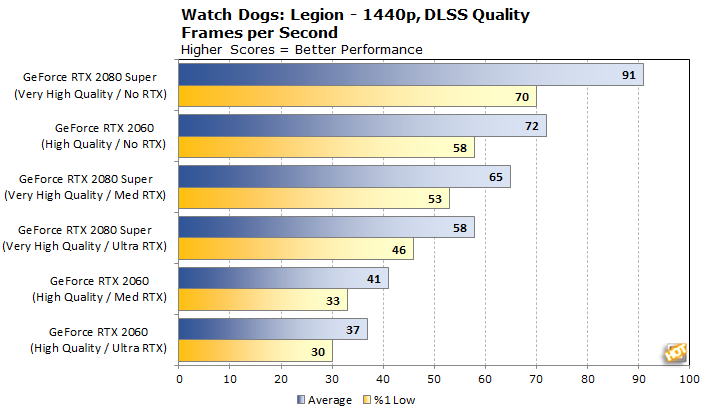
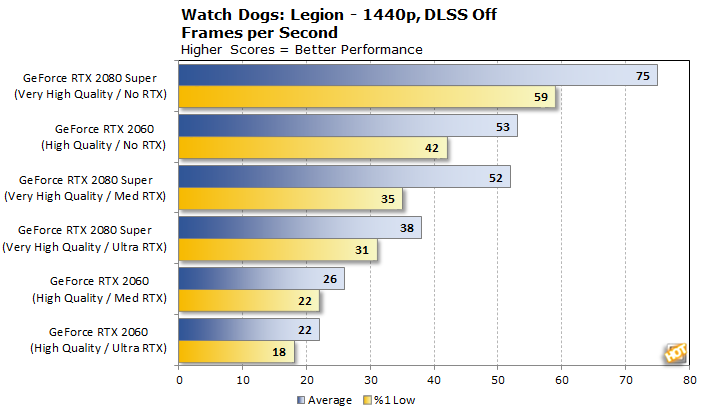
As expected, DXR exacted its performance toll at this higher resolution, but DLSS 2.0 was able to win back some of those precious frames. Already, the GeForce RTX 2080 SUPER was unable to provide a smooth 60 fps experience, although gamers with 1440p G-Sync capable monitors will still enjoy very solid performance. The GeForce RTX 2060 couldn't cap 60 fps even without DXR, which is pretty rough. In all cases, DLSS Quality mode is a bit faster than 1080p native rendering, since it renders the game at 1706 x 960. It looks pretty good this way, too, as detailed on the previous page.
|
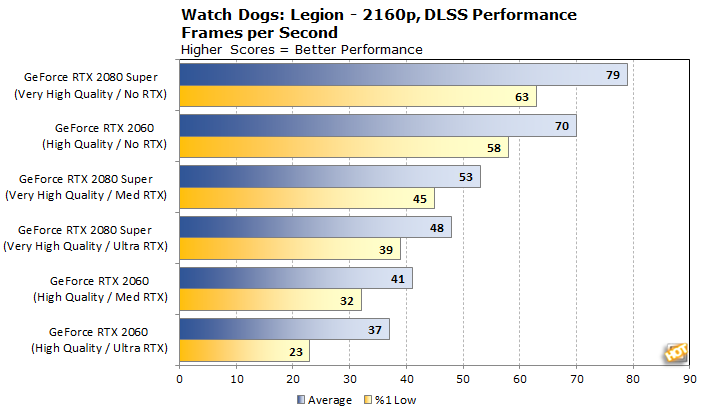

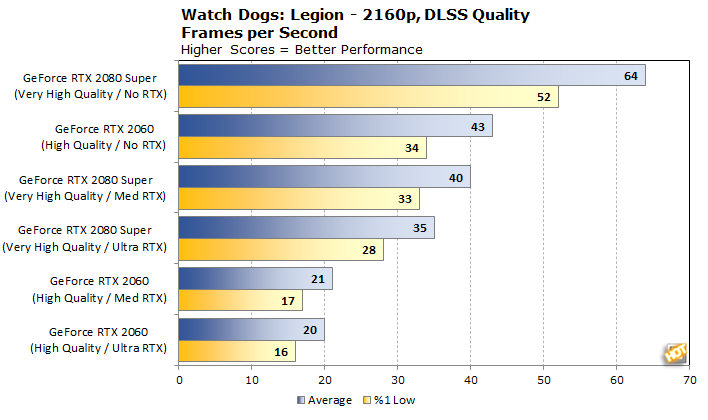
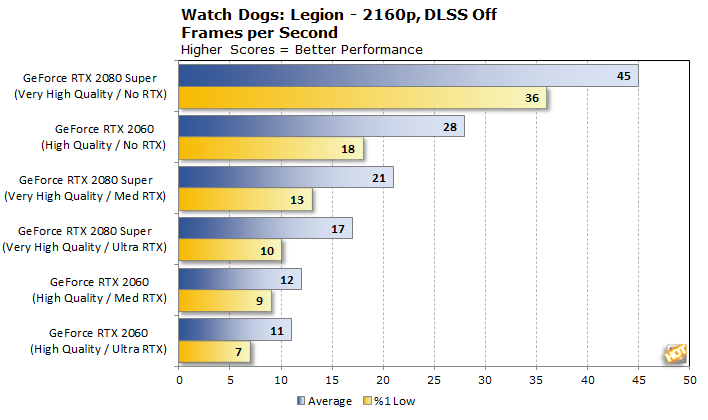
Performance Summary
Well, now we understand why Ubisoft set such aggressive targets for its recommended and ultra system requirements. The game is extremely playable with any GeForce RTX card, as long as the targets are set low enough. The nice thing is that even on that Minimum spec's setting, the game is beautiful. An equivalent to 1080p Quality DLSS is 1440p with Performance DLSS, and the game runs quite well on 1440p displays, and it looks better than even 1080p native because of the upscaling.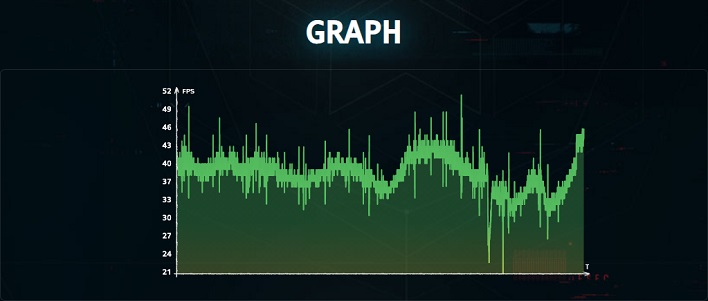
We didn't have much that we could test Radeons on, since the current 5000 series doesn't support DXR, and DLSS is an NVIDIA-only feature, so they were excluded. We do expect the game is quite enjoyable with a Radeon RX 5600 XT or 5700 series, since with traditional rendering, those cards are pretty even with an RTX 2060 and bookend an RTX 2070 SUPER.
We did do a couple of quick tests on our HTPC with the Core i5-9400F, and it doesn't appear that the CPU is a bottleneck. Performance was quite acceptable on that system at 2160p with Performance DLSS and Medium DXR on the Very High Quality preset. It wouldn't be fair to include that system on these charts, however, since it's a different platform with more variables than just the CPU.
Watch Dogs: Legion Conclusions
Watch Dogs: Legion is a pretty fun game with a lot to do. We had a blast zipping around London, hacking cameras, stealing drones, and recruiting allies in the constant fight against Albion. The story missions are engaging, and the side quests could keep us busy for hours all on their own. Having so many different player characters to recruit means that the game won't get old quickly, since there's always someone else's skills to enlist. Since each operative has their own skillset, many of the missions are tailored to one of the various archetypes. That can either make a mission very easy with the right recruit, or force us to think outside the box if we're playing as someone suboptimal for the job.Graphically speaking, this game is gorgeous. The textures are varied enough that the landscape didn't repeat itself in an obvious fashion, and the DXR effects on display were very nice. In fact, the game looks so good that when it stumbles, it's very obvious. Take the lack of interactive standing water as a case in point. While those raytraced effects could sap performance, DLSS 2.0 does a very nice job of injecting a speed boost that kept the visuals moving smoothly. The system requirements, while quite steep on the high end, should still be capable of delivering a smooth experience at high resolutions and detail levels.
The only downside is the somewhat buggy state we experienced the game in. Some of the clunky UI should be simple enough to smooth out, but there are more serious issues. Crashes during benchmarking thankfully didn't carry over into actual game play often, but when they happened, we'd lose progress and have to replay a section of a mission. When NPCs get stuck in walls or start floating after getting hit or when hijacked robotics get stuck on an object, it can make completing a mission difficult.
We definitely see the promise in Watch Dogs: Legion, and think it's a really solid game that just needs a bit of polish. If Ubisoft can shine up the wonky bits and shore up stability, it'll be a hit. While multi-player isn't here yet, it's scheduled to drop in December, which should extend the life of the game. If stealth and futuristic sci-fi conspiracies are your spot of tea, we'd suggest dropping into Jolly Old London.

